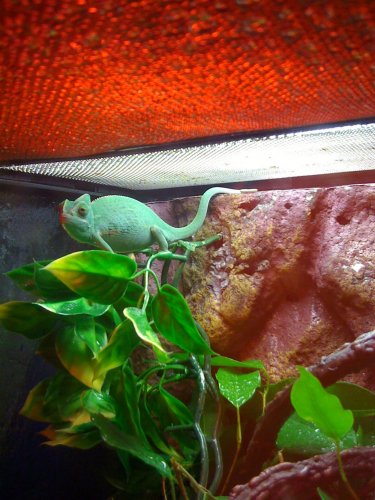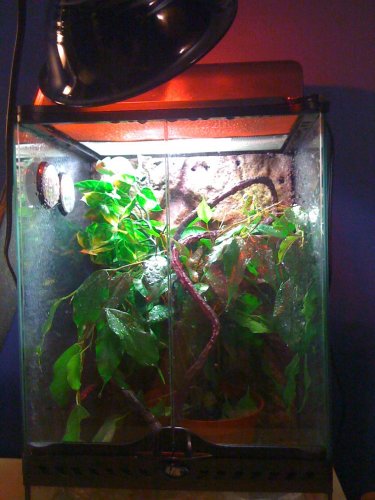comtec101
New Member
Hello everyone. I am new to the community and maybe others here can relate but I am surprised by how much diverse information I get from petstores and even vets about how to care for my Chameleon. What I would like to do in this post is explain my setup and hopefully some experts here can agree on a few things.
Firstly, I purchased my first veiled chameleon September of last year and she passed away 3 weeks ago due to many problems. Started with calcium deficiency and she was very dehydrated and would hardly eat. Once we got her eating, I woke up one morning and her rectum had prolapsed. I was able to get it back inside her but she didnt live for much longer afterwards.
After my first chameleons death, I didnt want to give up. I really enjoyed my last Chameleon and I feel if I knew what I was doing, I would have the dedication needed to raise a healthy Chameleon. Here is my current setup:
Lighting: Repti Glo 10.0 UVB Compact Bulb from Exo Terra
(Edit: Changed back to 5.0 UVB today)
Heat Lamp: Heat Glo 100W Infrared Heat Bulb from Exo Terra
- Basking spot stays around 85 degrees
(Edit: Changed to 75W Bulb, it was getting too hot)
Plants: I have a small ficus plant inside the terrarium as well as a few fake leaves (where the basking spot is)
- Humidity stays between 30%-70% depending on time of day. Mornings its dry because I dont have an automatic mister. Any suggestions for one would greatly be appreciated.
Water: This is what worries me most, I dont have any kind of a dripping system but I spray down the terrarium at least 5 times a day for about 20 seconds each. One of the problems for my last chameleon was dehydration. Any suggestions for a dripping system or a better way to keep my chameleon hydrated would be great.
(Edit: Purchased "The Little Dripper" and it works like a charm. I think ill wait until I get my new terrarium before installing a drainage system. Also reduced the amount of misting sessions but increased the duration. Misted twice today for about 45 seconds each)
Substrate: I used to use terrarium bark but the terrarium would easily get stinky and moldy. I had a friend suggest tiny rocks at the bottom so it stays more clean. Water builds up much easier at the bottom and its hard to keep the terrarium humid.
(Edit: All tiny rocks/small objects have been removed from terrarium. Substrate is no longer used)
Feed: I feed her about 10 small crickets a day and she eats about 5-6 mealworms from my hand. She doesnt hesitate when she sees food. Most petstore agents I talk to say 4-5 crickets a day but I feel like that would starve my chameleon. Will she stop eating when she is full? I havent seen her eat from the ficus leaves but I also hear they dont eat plants until adult age.
(Edit: Immediately ditched the mealworms after reading about the health risk. Purchased wax worms for a variety but only feeding 1-2 every other day. Plan on using silkworms, superworms, crickets and waxworms as her diet to keep a variety)
Suppliments: Reptivite - With D3.
Guy at petstore said dust crickets once a week with this but this worries me if my chameleon isnt getting enough calcium because ive been told crickets need to be dusted with calcium once a day. Is there any other suppliments I should be using and how often?
(Edit: Switching to Reptivite without D3 5 times a week and reptivite with D3 once every other week alternating with a multivitamin)
Thanks everyone in advance. I realize these are very basic and general questions but I have been so frustrated by the different responses I get from vets and store agents. I want a healthy chameleon this time not a dead one.
Ive attached a picture of my chameleon and my terrarium for reference. Thank you all again.
Steve
Firstly, I purchased my first veiled chameleon September of last year and she passed away 3 weeks ago due to many problems. Started with calcium deficiency and she was very dehydrated and would hardly eat. Once we got her eating, I woke up one morning and her rectum had prolapsed. I was able to get it back inside her but she didnt live for much longer afterwards.
After my first chameleons death, I didnt want to give up. I really enjoyed my last Chameleon and I feel if I knew what I was doing, I would have the dedication needed to raise a healthy Chameleon. Here is my current setup:
Lighting: Repti Glo 10.0 UVB Compact Bulb from Exo Terra
(Edit: Changed back to 5.0 UVB today)
Heat Lamp: Heat Glo 100W Infrared Heat Bulb from Exo Terra
- Basking spot stays around 85 degrees
(Edit: Changed to 75W Bulb, it was getting too hot)
Plants: I have a small ficus plant inside the terrarium as well as a few fake leaves (where the basking spot is)
- Humidity stays between 30%-70% depending on time of day. Mornings its dry because I dont have an automatic mister. Any suggestions for one would greatly be appreciated.
Water: This is what worries me most, I dont have any kind of a dripping system but I spray down the terrarium at least 5 times a day for about 20 seconds each. One of the problems for my last chameleon was dehydration. Any suggestions for a dripping system or a better way to keep my chameleon hydrated would be great.
(Edit: Purchased "The Little Dripper" and it works like a charm. I think ill wait until I get my new terrarium before installing a drainage system. Also reduced the amount of misting sessions but increased the duration. Misted twice today for about 45 seconds each)
Substrate: I used to use terrarium bark but the terrarium would easily get stinky and moldy. I had a friend suggest tiny rocks at the bottom so it stays more clean. Water builds up much easier at the bottom and its hard to keep the terrarium humid.
(Edit: All tiny rocks/small objects have been removed from terrarium. Substrate is no longer used)
Feed: I feed her about 10 small crickets a day and she eats about 5-6 mealworms from my hand. She doesnt hesitate when she sees food. Most petstore agents I talk to say 4-5 crickets a day but I feel like that would starve my chameleon. Will she stop eating when she is full? I havent seen her eat from the ficus leaves but I also hear they dont eat plants until adult age.
(Edit: Immediately ditched the mealworms after reading about the health risk. Purchased wax worms for a variety but only feeding 1-2 every other day. Plan on using silkworms, superworms, crickets and waxworms as her diet to keep a variety)
Suppliments: Reptivite - With D3.
Guy at petstore said dust crickets once a week with this but this worries me if my chameleon isnt getting enough calcium because ive been told crickets need to be dusted with calcium once a day. Is there any other suppliments I should be using and how often?
(Edit: Switching to Reptivite without D3 5 times a week and reptivite with D3 once every other week alternating with a multivitamin)
Thanks everyone in advance. I realize these are very basic and general questions but I have been so frustrated by the different responses I get from vets and store agents. I want a healthy chameleon this time not a dead one.
Ive attached a picture of my chameleon and my terrarium for reference. Thank you all again.
Steve
Attachments
Last edited:





